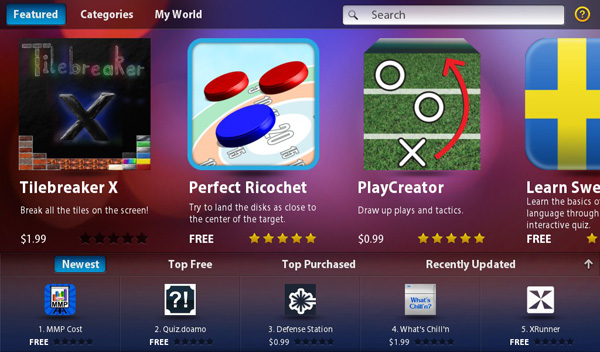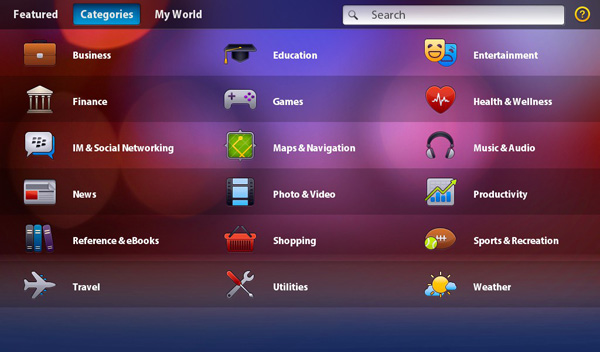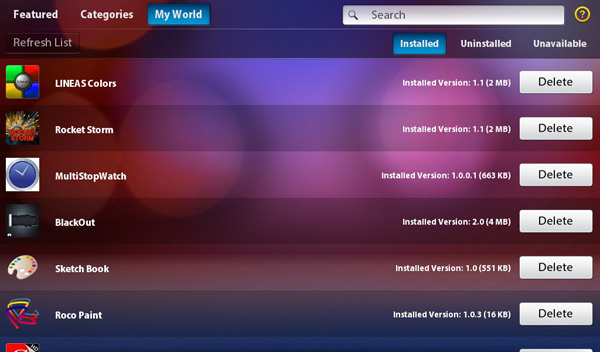The BlackBerry PlayBook Review
by Anand Lal Shimpi on April 13, 2011 9:00 PM EST- Posted in
- Tablets
- Smartphones
- RIM
- BlackBerry
- PlayBook
- Mobile
Apps and Development
Everyone loves to repeat Apple's iOS app number verbatim: "65,000 iPad apps and counting" was the talking point after the iPad 2 launch event. In reality, that's hundreds of times more than the number of apps you'll actually use on a regular basis. Most of the really popular apps are cross platform, at least when it comes to iOS and Android. There are definitely iOS exclusives just as there are Android exclusives, perhaps more of the former than the latter but ultimately I don't put too much weight on quantity of apps. If there's something in particular you want that doesn't exist for one platform but does for another, that's worth talking about.
The PlayBook app experience, at least on day one, unfortunately isn't anywhere near that of what you get on Honeycomb. So if you felt that Honeycomb was under-supported by 3rd party apps at launch, the PlayBook will disappoint you.
Let's first talk about App World - RIM's app catalog on the PlayBook. Apps are divided into categories and you can of course look at the top free, top purchased, newest and recently updated apps. I haven't encountered an app that needs updating so I'm not entirely sure how that process works yet.
Browsing for apps by category is a bit more complicated than I'd like. Each category seen in the screen below has a handful of subcategories:
I've noticed that app categorization doesn't always match up with the sub categories properly. There is of course full text search in App World, which seems to work well except that there just isn't that much to search for today.
One nice feature of the App World app is the My World page. Here you get a list of everything you've installed on the app (including size and version number) and you're given the option of deleting apps from here.
RIM also provides you with a list of apps you've deleted and gives you the option of reinstalling any of them. So if you deleted something you end up missing, you don't have to go searching for it again - it's just in the uninstalled tab in My World. Deleted/uninstalled apps don't physically reside on your device so they'll have to be re-downloaded, but the convenience is still nice.
You don't need to login with your BlackBerry ID to download free apps, but anything you have to purchase requires an authentication step.
App World is one of the few first party apps that just isn't very smooth. Animations are choppy and the whole thing just begs to be optimized. I can't stress enough how having a mixture of 60 fps and sub-30 fps frame rates on the same tablet somehow stands out more than if the device were just consistently below 30 fps.
RIM sent along a list of companies that are working on PlayBook apps, however I don't have specifics as to what they're working on or when it'll be released:
· Adobe Connect & Lifecycle
· Airplay
· Atari
· BoxTone
· Cerner Corporation
· Digital Chocolate
· EA
· eBay
· EpixHD
· Evernote
· FGL
· Fortune
· Gameloft
· Globe & Mail
· HFMUS - Car and Driver magazine
· Huffington Post
· Loblaws
· Mattel
· MediaFly
· OpenText Everywhere
· Post Media
· Salesforce.com - Chatter
· ScoreMedia (ScoreMobile)
· Slacker Radio
· Sports Illustrated
· Telicost (Anomalous Networks)
· The Weather Channel
· The Weather Network
· Time
· Unity3D
In terms of developing apps for the PlayBook you really have three options: the WebWorks SDK, BlackBerry Tablet OS SDK for Adobe AIR and native C/C++.
The WebWorks SDK enables HTML5 and JavaScript based apps to run on the PlayBook, similar to what the original apps for iOS were like. The Tablet OS SDK for Adobe AIR lets you bundle and target the PlayBook with apps you've built using Adobe Flash Builder. And finally, the highest performance option is to obviously write native C/C++ targeting the PlayBook.
There is a fourth method of getting apps onto the BlackBerry PlayBook, using an as-of-now unreleased Android App Player. RIM is working on a port of Android that will run on top of QNX, abstracted from the underlying hardware/software (think VM). The Android App Player should be able to run all apps that work on Gingerbread (Android 2.3). You won't get access to the Android marketplace, developers will still have to package and send all apps to RIM for signing - but it should allow existing Android developers to avoid a full blown code re-write in order to get their apps working on PlayBook right away.
It's still far too early to see how successful this is going to be and I do have concerns about performance (the layer between QNX and Android is bound to cause a performance impact). Of course Android apps won't have direct access to hardware so things like 3D games are likely going to be too slow to work at all. It's an interesting option but I'll reserve judgement until I see it implemented in a shipping device. At this point I wouldn't assume that the PlayBook is just going to give you a great Android app experience as well as a great PlayBook experience. I think that's simply too far fetched.














77 Comments
View All Comments
legoman666 - Wednesday, April 13, 2011 - link
No email client? Really? Is that a joke?Ethaniel - Wednesday, April 13, 2011 - link
For now it seems, but that's clearly a sample unit. All I keep reading is "needs tuning" and "needs optimization", ergo, it's not ready, and they're going to launch it anyway. Those updates will have to be lightning-fast. I don't want to pay 500 dollars to be a beta tester...SimKill - Wednesday, April 13, 2011 - link
I'm actually surprised. This is because my cousin in India said that his friend in Dubai already bought it and has it for quite some time. Do you think there might be a reason why they are purposely delaying the American release?melgross - Thursday, April 14, 2011 - link
Probably, someone is lying about it, or they've gotten some illegally obtainedRe
Reduction model much as what happened the Apple's iPhone 4.
It's first being released in N. america, according to RIM.
vol7ron - Friday, April 15, 2011 - link
Why does everyone want to price around Apple? The more I look at these devices, the more I'm likely to get the color-nook and put Droid on it. Surely the hardware would be lacking, but the functionality would still be ballpark.16GB for $500 is ridiculous. These base models need to be in the $250-300 range.
michael2k - Friday, April 15, 2011 - link
Um, the raw materials for the iPad is about $260, meaning you can't expect to buy a 16gb tablet from any manufacturer, especially one with less buying power than Apple, for much less than $400 or so.From the iPad 2:
Display is $127
Flash is about $66 for 32gb, $35 for 16gb
Case & Battery is about $60
Mobo+Camera is about $60
So for any 10" tablet the cost if they gave it away for free would be $282 or so. Your nook "cheaps out" by having a 7" screen, only 8gb storage, a slower CPU, no cameras, and a much smaller battery. It only gets 8 hours with wifi off, the iPad 2 gets 11 hours with wifi on!
In other words you're only paying $180 worth of HW in the Nook, while the iPad gets you two 1GHz cores vs a 800MHz core, 11h of battery vs less than 8 hours, 10" and 1024x768 vs 7"@1024x600, 16gb vs 8gb, and of course, no guarantee of OS updates. You're complaint is ridiculous, actually, since almost no other manufacturer has been able to beat Apple on price yet except the Acer Iconia.
quiksilvr - Friday, April 15, 2011 - link
As much as I despise Apple, I have to agree to an extent. Yes that price is quite hefty, but if Apple didn't have it's cult following, it would have easily been on sale for $399. But thanks to idiot consumers, they can bump it up a Benjamin.michael2k - Friday, April 15, 2011 - link
And no one else can order in vast enough quantities to hit the $399 price.mcnabney - Friday, April 15, 2011 - link
I am starting to doubt the iSupply numbers you quoted.They price the very nice 9.7" IPS screen that Apple uses at $129 while the clearly inferior non-IPS screen the XOOM uses at $140. Their memory prices are also highly suspect, clinging to $2/GB for what are still really small drives compared where higher performing SSDs already are. I would guess that NAND prices for tablets are under $1/GB wholesale and in quantity.
michael2k - Friday, April 15, 2011 - link
Apple orders literally 2m 9.7" IPS screens a month, probably 40m this year alone. That gives them bulk purchasing power no one else has except the manufacturer of said screens.Motorola has to pay market prices, while Apple can literally buy an entire factory's output. http://www.isuppli.com/Display-Materials-and-Syste...
It doesn't help that the Japanese earthquake halted LCD production at major plants, either!
As for SSD chips, Apple is paying a premium to get density. The low end iPad has only a single SSD 16GB chip. The mid range iPad has one or two, and the high end has two 32GB chips. As soon as prices are good or capacity is good, I'm sure Apple will use a single 32gb chip on the low end, two 32gb chips for the middle, and 2 64gb chips on the high end.